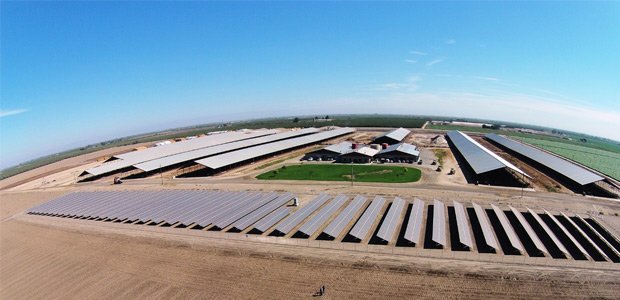7 Theses on Storage Systems in Commercial Applications

Solar storage systems are now the focus of attention more than ever before. The application areas are as different as the requirements. While private PV system operators work toward optimizing self-consumption, storage systems in industry are mainly used to provide control reserve and thus ensure grid stability.
In commercial storage system applications, the main focus is on efficiency and a secure electricity supply—it is a question of balancing load and demand peaks and providing an emergency electricity supply in the event of grid failures. Flexible, custom-tailored system solutions for complex load and requirement structures are called for here. The SMA experts Volker Wachenfeld, Executive Vice President Off-Grid & Storage Business Unit, and Nick Morbach, Executive Vice President Commercial Business Unit, discuss different topics.
1. “Batteries are the missing piece in the puzzle of global regenerative energy generation” – Elon Musk, CEO Tesla

Volker Wachenfeld has a degree in electrical engineering and is Executive Vice President of the Offgrid & Storage Business Unit at SMA.
Volker Wachenfeld: Although Elon Musk said that primarily in reference to his own products, the message is, without a doubt, universally valid: There is no stopping renewable energies. This also means that their already discernible volatility, due to fluctuations in energy generation depending on supply, will definitely increase significantly. Storage systems attenuate this volatility or even counteract it completely. They make grid integration easier and stabilize the global energy supply system, both statically and dynamically.
Nick Morbach: The principle must be “generate energy where it is needed and provide it when it is required.” For an electricity supply with solar energy alone, in theory, hardly any more space is required than is already available on residential, commercial and industrial buildings. If we use these areas for solar generation and add storage systems, anything is possible in theory. To this end, storage systems practically only have to become less expensive. However, we are already on the road toward achieving this.
Volker Wachenfeld: The price of battery-storage systems has fallen significantly over the last two years. Engaging appearances such as that of Elon Musk at the presentation of the Tesla Powerwall are playing no small part in increasing awareness of this issue. PV systems with storage systems are no longer viewed as incredibly complicated technology but are an easy means to join the energy transition and, as a system operator for example, even become part of a virtual power plant. If we combine wind and solar power with battery-storage systems to create virtual power plants and thus intelligently manage millions of decentralized systems together, a secure electricity supply from regenerative sources will no longer be a problem at all. Naturally, political figures must want this as well. The question then must not be about whether to install a storage system to complement a PV system but how large the storage system must be, in an ideal world, so that it is a perfect match for the entire system consisting of appliances, storage systems and the PV system?
2. Do storage systems pay for themselves?
Volker Wachenfeld: SMA has been building storage system solutions for commercial applications in the off-grid segment for years. In off-grid regions, the primary focus is on establishing an electrical energy supply in the first place, one that facilitates economic development. As the demand for energy increases, the systems can be expanded up to a size of 300 kilowatts by means of modules.
In addition to the economic aspect in a commercial setting, our grid-connected storage system solutions for applications up to 100 kilowatts meet additional and different requirements. For example, the agricultural industry also needs a secure electricity supply. What happens if the milking machine, the heating lamps for rearing young animals or the ventilation in the henhouse fail due to a power outage? In such a case, storage systems can provide the necessary energy at any time. The same applies for hospitals, hotels and schools. Parking garages can use the storage systems to offer electricity to charge electric cars without increasing the connection power. Shipping companies can generally use storage systems for similar purposes in the field of solar maritime navigation. In Germany, we currently allocate around 10 percent of grid-integrated storage systems in the country to the commercial segment in terms of size and application.
Nick Morbach: A commercial system optimizes the operator’s energy balance. This is basically similar to how a system operates in the Residential segment, where the storage system is nowadays used almost exclusively to manage self-consumption. Nevertheless, commercial operators do have additional optimization criteria. For example, in this segment, the electricity price is made up of the traditional energy charge, i.e., euros per kilowatt hour, and a demand charge, i.e., an additional amount for the peaks in procured power. By means of a battery-storage system, the demand peaks can be reduced or moved to off-peak periods. To optimize this, a professional energy management system tailored to industrial requirements and linked to the building technology is required. At SMA, we are working diligently on providing our customers with such a system as part of our range of solutions.
Even at weak grid-connection points, the storage system offers businesses additional opportunities to generate inexpensive electricity themselves using a PV system. The storage system prevents the grid connection from being overloaded, thereby facilitating the further expansion of decentralized generation in commercial applications as well.
Volker Wachenfeld: In utility applications like in Mexico or Hawaii, storage systems are used to integrate renewable energy into the utility grid. It is a question of limiting ramp slopes, etc. In the U.S., South Korea and indeed in Europe, large storage systems are connected to the utility grid in the utility segment in order to provide control reserve. In all these cases, the storage system is used to stabilize the utility grids.
3. Commercial storage systems are equally attractive for both PV system and grid operators
Volker Wachenfeld: Unfortunately, this is not the case. At present, the storage systems are only attractive for the PV system operator; there are still no suitable business models for the grid operator. This situation definitely needs to be rectified. As a universal energy manager, the storage system allows generation and demand to be adapted to each other in terms of time. This is in contrast with electricity grids, which distribute the energy spatially. This adjustment is extremely attractive for the operator if the energy has a different value at different times, i.e., if it can be provided at a high price at some times and at a low price at other times. This applies both for procurement from the utility grid as well as for generation.
4. Commercial storage system solutions are in demand globally
Nick Morbach: In so-called mature PV markets, in which many companies have already been equipped with PV systems that sometimes already feature energy management functions, the tariff models are of decisive importance. As already mentioned, the electricity price in the commercial sector is made up of two components. The issue of demand charge plays a role in nearly every market, whereby the actual price can vary considerably depending on the market. Energy charges, however, are already offered in a tiered structure in some markets. These are called time-of-use (ToU) tariffs. By using a storage system solution, we can both reduce the power peaks (and hence the demand charges) and, at the same time, systematically charge and discharge the storage system at specific times by means of variable tariffs. In Germany, the share of the energy charge that actually depends on the procurement costs is unfortunately less than one-third. More than two-thirds is made up of taxes and fees. Such a structure makes the use of time-of-use tariffs for the purpose of arbitrage models based on storage systems virtually impossible. [Note: Arbitrage (French: arbitrage, Latin: arbitratus—discretion, free choice) means taking advantage of price differences for the same goods on different markets. Source: Wikipedia]. However, the U.S., for example, is now emerging as one of the most attractive markets, both because of the level of the demand charges and due to the attractive ToU structure.
Volker Wachenfeld: But under no circumstances should we lose sight of countries such as India. Due to the poor grid quality, storage systems can also take on an important role here to ensure a stable electricity supply. We have gained good experiences with our commercial hybrid system in Tamil Nadu. There, electricity is expensive, unreliable and a constant annoyance for companies engaged in production.
5. Retrofitting existing PV systems with storage systems is economically viable
Nick Morbach: Integration into existing generation systems is basically not a problem. Ultimately, it’s a question of what is least expensive at a specific time: moving electricity from the generation system into the storage system, consuming it directly or even feeding it in as excess. Likewise, there are other times when we must decide whether to purchase and save inexpensive grid current, perhaps because a load peak is imminent, or else to take energy from the storage system to cover demand because inexpensive grid current will shortly be available for recharging. And regardless of this, storage systems can already be financed wherever the power prices are high enough.
Volker Wachenfeld: Commercial storage systems are basically more strongly decoupled from PV applications than domestic storage systems. While the focus in the domestic setting is on maximizing self-consumption (i.e. the size of the PV system, the storage system’s capacity and the domestic electricity consumption have to be coordinated with each other), the energy price structure plays a much larger role in dimensioning in a commercial setting. In keeping with this, the PV systems will be designed to be quite technically independent of decentralized generation. Sometimes, a large generator with a small storage system makes more sense; sometimes, a small generator with a large storage system makes more sense. And ultimately, there will even be times when it will work without any photovoltaics at all if the price range is within the variable electricity tariff or the power price is only high enough. For the retrofit market, we must take into consideration the fact that the PV systems have mostly been connected to the utility grid at times of generous feed-in tariffs – this is true of all other segments as well. As a result, the retrofitting of PV systems will be kept within limits. Thanks to the greater decoupling of the generation system from the storage system, the operator can also reach a decision completely independently of this. I’m going one step further: existing storage systems will be complemented by PV if the procurement prices on the market in question rise more sharply and the PV generation costs continue to fall. Different models are encountered here, and our solution must be flexible enough to deal with this.
6. AC-coupled storage systems are more efficient than DC-coupled solutions
Volker Wachenfeld: This is most definitely true of the larger PV systems from the commercial world. After all, these systems are primarily designed in accordance with the company’s energy demand, and particularly in accordance with the load profile. The important parameters such as the PV system’s storage capacity and size are very application-specific. For this reason, flexibility in design is one of the most important requirements. Adapting to almost any individual PV system configuration is only possible with AC-coupled systems. In this way, systems can be created with different storage capacities as well as with different PV system sizes. Particularly in larger PV systems, DC-coupling would require every PV inverter to have its own battery, and this in turn would considerably expand the battery installation outlay.
Nick Morbach: The DC-coupling of the storage system restricts the PV system’s flexibility with regard to both its performance as well as the mounting location. In order to guarantee an optimum battery life, it makes sense to install the storage system in such a way that it is protected (e.g. inside the building), and not so often in the vicinity of the PV inverter. In this way, even the capital expenditure on the storage system is lowered as, depending on the ambient conditions, a special housing with a high protection class does not have to be assigned to every battery.
7. There is NOT JUST ONE battery manufacturer
Volker Wachenfeld: The developments on the storage system market are currently taking place at breakneck speed. New generations of battery cells are launched on the market almost every year. We monitor this development intensively, and again and again we have to re-assess which manufacturer currently offers the most attractive solution for our systems. Being bound to one single partner would restrict us considerably here. For this reason, we have standardized the interface between battery and inverter and are open to collaborating with pretty much all battery manufacturers.
Nick Morbach: The focus is on flexibility here as well. Particularly for our commercial customers, we need flexible solutions and therefore take a very close look at which PV system, which battery type is the most suitable for ensuring an optimum PV system design.
Picture above: The dairy farm in California uses solar power for its own power supply.
The PV system provides low-cost, clean electricity, which covers already more than 86 percent of the farm’s electrical needs. An additional battery-storage system could optimize consumption behavior even further by reducing demand peaks or moving them to off-peak periods. A storage system would, for example, ensure that the energy supply of the milking machine can be maintained even during a power outage.



Feel free to contribute!